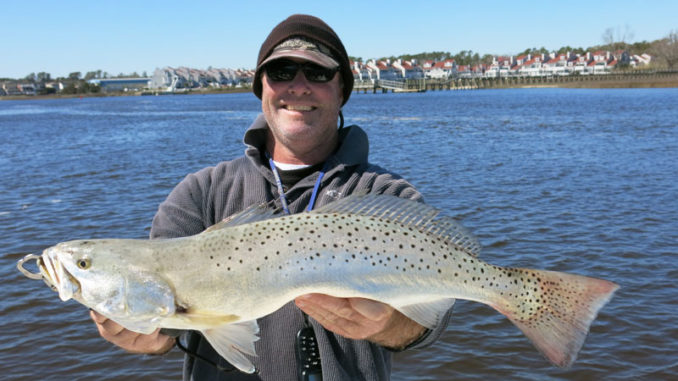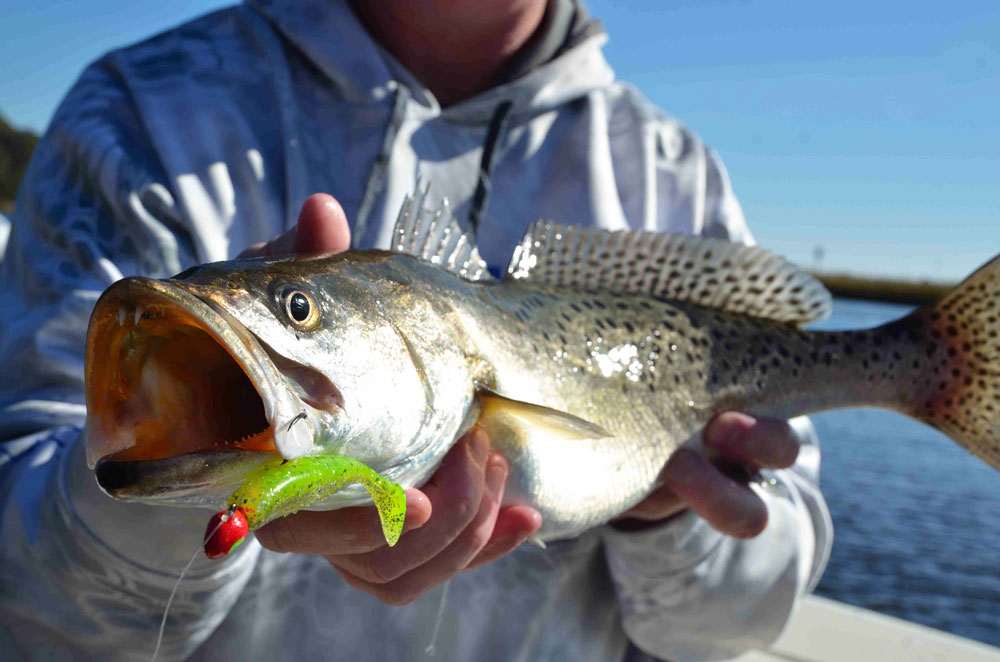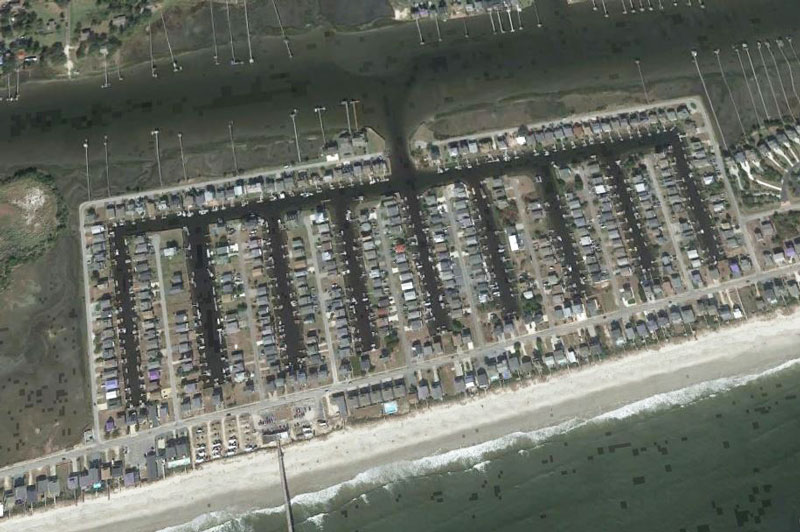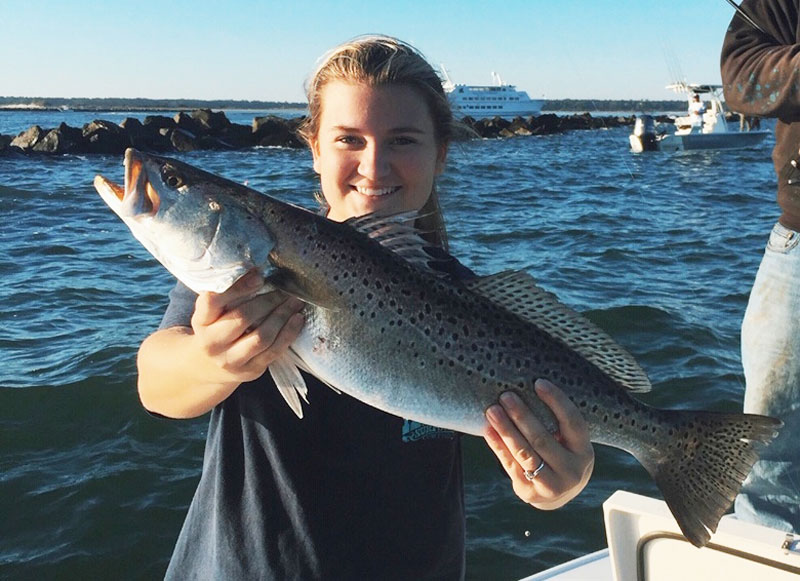
Trout will start biting at the first sign of warm weather, and the waters around the border between the Carolinas is a great place to start.
The seasons make a dramatic change this month with the onset of spring and warmer temperatures. If inshore fishermen didn’t get their line stretched enough in the fall, March shapes up as an ideal time for a spring frolic in the waters along the North Carolina-South Carolina state line, with speckled trout in the spotlight.
Springtime in the Carolinas is always unique, with unpredictable weather and bipolar water conditions. The runs of warm-weather days will overtop the cooler days, and the speckled trout bite takes off as soon as the water temperatures begin to trend upward, in places where anglers in boats of all sizes can target them.
Tripp Hooks of Captain Hook Outdoors is a diehard saltwater angler and guide based out of Ocean Isle Beach, N.C. Although he does a lot of fishing offshore, he loves following speckled trout throughout the year. The Intracoastal Waterway is his first stop and generally his spring playground for specks.
“In the ICW, they have everything right there,” Hooks said. “They have access to deep water and shallow banks right in the same place.”
The trout bite in the ICW from Little River, S.C., to Holden Beach, N.C., fires up when spring arrives. The ICW provides a perfect environment for the unpredictable spring conditions.
“When the water is cold, the trout will be along the deep side of the 15- to 20-foot ledges, but when it starts to warm up a lot, the surface temperature will be warmer than the bottom, making the bite better closer to the surface,” he said.
In the spring, the air temperature can be 40 degrees one day and 75 degrees the next. Water temperatures remain relatively stable in the ocean during these roller-coaster conditions, but inshore waters can experience dramatic temperature changes during a period of a few warm days. While most fish prefer a more-stable environment, trout and other inshore finfish will take full advantage of the spring warm-up by moving into these shallow, warmer reaches to feed.
In addition to the ICW, Hooks will fish just inside the mouth of area rivers and large tributaries.
“The ICW is a go to spot, but the shell banks near the end of the Calabash and Shallotte rivers will also hold fish in spring,” he said. “I fish the first mile of these main creeks and rivers that are covered in shell.”
The ICW and area rivers are covered with oyster banks that are a key component to speckled trout habitat. The ICW sustains the majority of the available baitfish in the spring. The shells provide a place for bait to hide and for the trout to ambush them. In addition to oyster banks, the ICW provides fish and fisherman with other types of habitat that can be prime spring trout locations.

Tom Cushman of Captain Cush’s Calmwater Charters out of Little River, S.C., fishes for trout year-round, and he loves the ICW around Little River because of all of the man-made structure that concentrates bait for his trout and redfish expeditions.
“We have a lot of docks and other structures along the ICW that hold fish,” said Cushman (843-997-5850). “Most of the docks extend into deep water to allow seasonal docking on all tides. The ends of the docks are deeper and usually the best place to find trout in spring.”
Several bridges that cross the ICW around the state line will hold trout throughout the year: Ocean Isle Beach, Little River, Holden Beach and Sunset Beach.
“The Sunset Beach bridge is one of my favorite places for trout in the spring,” Cushman said.
Marinas shouldn’t be left off the list, either. The waters in the vicinity of the state line have several marinas that can offer a bonus fishing situation for spring fishing.
“The marinas will warm up and hold bait during the spring. We will catch them in the marinas or at the mouth of the marinas on the falling tide. The falling tide is always better in the spring,” Cushman said, explaining that ocean waters flowing in on a rising tide are significantly colder than inshore waters and won’t produce as good a bite as warmer, inshore waters flowing out.

Since baitfish are limited, anglers typically use mud minnows or artificial lures. Mud minnows aren’t typically a trout bait, but specks will readily hit them, especially fished under a popping cork or on a jighead in deeper places. Hooks is a fan of soft-plastic lures and topwater baits.
“I like to throw a topwater lure early, late, and in periods of limited light,” he said. “But the rest of the time, I will use Saltwater Assassin’s paddletails and Vudu Shrimp.”
Surface lures are most effective when trout have moved onto the shallower oyster bars and ledges in 2 to 3 feet of water. Both poppers and stick aits can produce in the spring.
Hooks will work subsurface lures slowly, beginning in deep water and up the ledge to the shallower waters until he finds a school of takers.
“In spring, the trout will be in tight packs, not too far from each other. If you catch one, there will be several more in the same spot,” he said.
Zero in on man-made canals
The beaches in lower Brunswick County, N.C., are filled with man-made canals that are used for temporary and long-term boat storage — nearly 40 between Holden Beach, N.C., and the South Carolina line, as well as, a few in Cherry Grove, S.C.
While these canals were built for homeowner boat access, they provide an excellent winter and spring hangouts for redfish and speckled trout.

These canals are protected from the wind and often trap heat that warms the waters. While temperatures will not be excessively higher, several degrees can produce ideal conditions for baitfish and predators.
All of the canals aren’t created equal though. They can be long, short,and configured as a single canal or a collection of short canals with a collector and a single opening to the ICW. Trout can be found from the tips of the canals to the canal openings and anywhere in between.
Anglers should fish the entire reach of canals to find the best spots holding fish. The majority of these canals are relatively shallow and both subsurface and surface lures can produce fish. The best fishing is with artificial shrimp, sinking/suspending MirrOlures and jigs rigged with soft plastics. Anglers should also try mud minnows under popping corks. The action of a mud minnow can be deadly on trout and redfish in canals.
Don’t forget jetties in spring
Speckled trout are a favorite of many anglers, and the jetties on either side of Little River Inlet can be ground zero for some of the biggest fish caught all year.
While most anglers fish the jetties during the fall, spring is also a good time to pitch baits along the massive collection of granite boulders.
While many fish overwinter inshore, plenty spend the cold months in the ocean where temperatures are more consistent. The jetties provide a unique feature that provides refuge and feeding opportunities. Trout don’t have to be concerned about any major changes in water temperature while they’re around the jetties.
In spring, the outgoing tide will push warmer water and baitfish up against the jetty rocks, where many trout will be set up looking for an easy meal.

Tripp Hooks of Captain Hook Outdoors loves to fish the jetties for speckled trout and redfish.
“I fish the jetties every time of the year,” Hooks said. “They can be stacked up there one day and nothing there the next, but I always check the jetties. They are a good spot to try any time of the year.”
Hooks fishes both the inside and the outside of the jetties.
“I like the inside on the falling tide and the outside on the rising tide because that is where the current is located. On the outside on the rise, the water sucks around the rocks and pushes through,” he said.
Hooks fishes as close to the rocks as possible. He will cast soft plastics on jigheads and artificial shrimp to the rocks and allow them to sink to the bottom before working them slowing off the bottom.
Destination Information
- HOW TO GET THERE — The waters along the North Carolina-South Carolina border can be access from public boat ramps at Ocean Isle Beach, N.C., Holden Beach, N.C., and Sunset Beach, N.C., and under the US 17 bridge over the ICW in North Myrtle Beach, S.C. See www.dnr.sc.gov/pubs/boatfacilities.pdf and www.ncwildlife.org/Boating_Waterways for exact locations.
- WHEN TO GO — March through May. The spring pattern begins when the water begins to warm in March and will continue until Memorial Day. When fishing inshore waters, choose the falling tide on warm days for best success. Concentrate on the ICW from the Little River swing bridge northeast almost to Southport, N.C. Man-made canals in Ocean Isle beach, Holden Beach and Cherry Grove (S.C.) are ideal places. Also, check bridges, docks and the mouth of creeks.
- BEST TECHNIQUES — Medium-light to medium action spinning gear spooled with 10- to 14-pound braid is preferred, with a 16- to 24-inch leader of 14- to 20-pound fluorocarbon. Mud minnows are the only live bait available in spring; they can be fished under a small popping cork. Productive artificials are soft-plastic shrimp and suspending hard baits. Use natural and bright colors. Vary your retrieve, but a slower, stop-and-go retrieve will produce the best results.
- FISHING INFO/GUIDES — Tom Cushman, Capt. Cush’s Calmwater Fishing Charters, 843-997-5850, www.captaincush.com; Tripp Hooks, Captain Hook Outdoors, 910-540-7332, www.capthookoutdoors.com. See also Guides & Charters in Classifieds.
- ACCOMMODATIONS — Hampton Inn, North Myrtle Beach, S.C., 843-249-1997; Causeway Inn, Ocean Isle Beach, S.C., 910-579-0743; Elliott Realty, 888-669-7853; Myrtle Beach Area Convention and Visitors Bureau, www.mbchamber.com; North Carolina Tourism, www.visitnc.com.
- MAPS — Navionics, 800-848-5896, www.navionics.com; GMCO’s Chartbook of North Carolina, 888-420-6277, www.gmcomaps.com.


